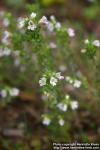Some plants get to be abundant in late summer (or early fall), only.
One of them is eyebright, Euphrasia. There's some near Perheniemi, and it was in full flower during the three days I taught there in mid-August. Euphrasia needs sand to grow, and I haven't found it growing anywhere near where I live.
 Pic: Eyebright in flower. And it's not abundant enough for picking in Perheniemi.
Pic: Eyebright in flower. And it's not abundant enough for picking in Perheniemi.
But in late August I was in Ruukki for four days. They have sand. And eyebright. And now I have eyebright, too. Whee!
It's a very small annual, and it's very difficult to pick it and not pull it up by the roots. That's not a problem if it really is abundant, nor is it a problem if the season is advanced enough that the largest plants have seeded already.
If neither is the case I suggest scissors. The stems are thick (given the size of the plant) and fairly robust, and a knife would need to be exceedingly sharp for cutting this plant. If you cut it above the nethermost few leaves it'll do its very best to put up a new flowerstalk and go to seed before winter. If you pull it up the plant is dead dead dead, with no possibility whatsoever of scattering any more seeds this year.
And I like to be able to go back to places where I've picked in earlier years, finding the same abundance again.
--
What to use it for? It's called eyebright because it has a reputation for making you see things clearer, both physically and metaphorically.
That's not because it's a herb for the eyes, it's because it's a herb for the liver. It's a scroph (in the Scrophulariaceae or figwort family), and it's one of the figwort family anti-inflammatories. A fairly nice one, too, which works for things like allergies.
Michael Moore, in his "tinctures" booklet, says to use eyebright for sinusitis, overactive eye secretions, conjunctivitis and similar. As I haven't had all that much eyebright before I've used the very abundant ground ivy (Glechoma hederacea) for inflammations of the mucosa of the head instead.
How to use the eyebright: I prefer teas. That's 1 teaspoon dried herb to 2 dl boiling water, let steep for 5-10 minutes, strain, and drink 1-3 cups a day. Try it for the next allergy season (April through October, over here), especially if you react to airborne allergens with your eyes and nose!


Comments
Euphrasia is considered an
Euphrasia is considered an "at risk" plant according to the United Plant savers web site. Have you found this to be true and do you have any information about why it is at risk? Perhaps because of the patterns of growth or the habitat in which growth occurs?
I wouldn't have a clue about
I wouldn't have a clue about eyebright in the US.
Also, the UpS at risk plant lists are skewed: if a plant is endangered in, say, southern Oregon, it's listed at risk even though it's extremely abundant further south. And similar things, all over the place.
Check the USDA site for real "at risk" plants, don't trust UpS.
Over here, it only shows up in July, and needs sand and something else to grow. And it's very very small, and thus easy to miss. If you were to look for it in June it'd be extinct pretty much everywhere ...